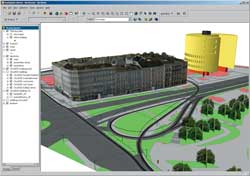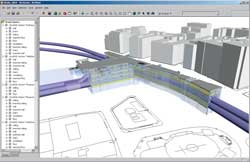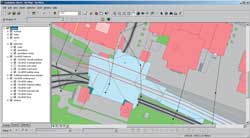Adding Another Dimension to Municipal Management
Continued...
Urban Planning
Taller commercial buildings are more interesting to investors. When determining the optimum height for a building, city planners try to avoid the negative impacts caused when a building is visible from critical points in the city. Using conventional methods, site height optimization is practically impossible. However, the three-dimensional city model can be used to determine an optimum height in just a few hours. Accurately represented roofs in the city model can be converted to a GIS-compatible grid height model that is used in ArcGIS 3D Analyst to perform visibility analyses.
Architectural Competitions
The designs submitted to architectural competitions should be evaluated on an objective basis. The three-dimensional city model can provide a standard framework for all entries. Using ArcScene or ArcGlobe, submitted designs can be simulated and assessed in different variants in an interactive three-dimensional visualization.
Generating a Subterranean Three-Dimensional City Model
The integration of subterranean structures in the city model started in 2005. Initially, structures associated with the 35 kilometers of underground train will be
 |
| A simulation of a designed building displayed in ArcScene |
incorporated into the model with the help of the existing design drawings. Most of these drawings are available only in hard copy. The three-dimensional modeling is carried out in the CityGRID system using the digitized structure lines from subterranean facilities. Relevant elements in the interior of the underground train facilities can also be modeled and, at this time, 9 kilometers of the Viennese line network have been recorded. The underground train models are saved in a three-dimensional database and can be presented two dimensionally in ArcMap or three dimensionally in ArcScene and ArcGlobe.
Additional underground supply lines must be carefully planned in city centers. The numerous existing supply lines limit the available space, and traffic obstructions created by excavation work should be kept to a minimum. Exact information on underground structures saves significant time and money, particularly when pipes must cross underground railway lines. The multipatch format lets ArcGIS correctly represent three-dimensional
 |
| A three-dimensional presentation of an underground train system displayed in ArcScene. This subterranean model is used for supply line management. |
underground structures. Because three-dimensional simulation and optimization can be performed in the early stages of the planning process, planning errors can be avoided.
All elements of the supply line cadastre are available in two dimensions. The underground train system, managed in the subterranean city model, is available in three dimensions. The city department of electronic data processing will make the supply line cadastre available in three dimensions. Because ArcSDE supports three-dimensional data structures, z-values for vertex coordinates will be obtained from existing height information.
Three-Dimensional Information Enhances Security
Underground railway stations are complex structures, especially stations that serve as transportation hubs. In addition to the multilevel areas and stairways accessible to the public,
 |
| A two-dimensional representation of an underground station (shown in light blue) together with sewer pipes (shown in red) that allows areas of potential collision to be quickly identified |
stations also include structures such as service rooms, ventilation structures, and connecting passages. Typically, each room has fire alarm sensors. If a fire breaks out, the sensor reports the room code to the central office. Actually locating the room is often difficult using conventional two-dimensional plans. Three-dimensional representations of the station offer a crucial orientation aid and help emergency workers reach a location more quickly. Displaying underground stations in a GIS-based system is an essential component of an up-to-date emergency system. In this context, the aboveground city model also provides valuable information on the station's surroundings. For more information on the City of Vienna's model, contact
Lionel Dorffner
City of Vienna
Municipal Department 41 Surveyors
Muthgasse 62, 1190
Vienna, Austria
Tel.: +43 (0)1 4000 89179
E-mail: lionel.dorffner@m41.magwien.gv.at
Gerald Forkert, Geodata IT GmbH
Huetteldorferstrasse 85, 1150
Vienna, Austria
Tel.: +43 (0) 1 786 30 20 411
E-mail: forkert@geodata.at
About the Authors
Dr. Lionel Dorffner is chief of the three-dimensional city modeling task force at the Vienna Municipal Department 41 Surveyors.
Dr. Martin Ludwig is responsible for GIS projects at the Vienna Municipal Department 14 Automated Electronic Data Processing, Information, and Communications Technologies.
Dr. Gerald Forkert is the managing director of Geodata IT GmbH.
|